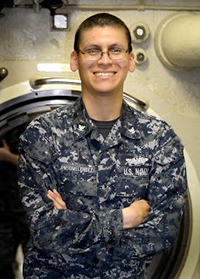By Kayla Good
Navy Office of Community Outreach
Pablo Alonso-Melendez, a 2012 Auburn Riverside High School graduate and Auburn native, is serving in the U.S. Navy as part of a crew working aboard one of the world’s most advanced ballistic missile submarines, the USS Henry M. Jackson.
Alonso-Melendez, petty officer 3rd Class, is a sonar technician (submarine) serving aboard the Bangor-based boat, one of 14 Ohio-class ballistic missile submarines.
A Navy sonar technician is responsible for operating submarine sonar, which allows them to be the eyes and ears of the ship.
“I enjoy the theory behind my job,”Alonso-Melendez said. “I enjoy tracking. It is the one thing that is most exciting about the job. We are always learning more about our responsibility. We strive for excellence.”
Measuring 560 feet long, 42 feet wide and weighing more than 16,500 tons, a nuclear-powered propulsion system helps push the ship through the water at more than 20 knots.
The Navy’s ballistic missile submarines, often referred to as “boomers,” serve as a strategic deterrent by providing an undetectable platform for submarine launched ballistic missiles. They are designed specifically for stealth, extended patrols and the precise delivery of missiles if directed by the president. The Ohio-class design allows the submarines to operate for 15 or more years between major overhauls. On average, the submarines spend 77 days at sea followed by 35 days in-port for maintenance.
Alonso-Melendez is part of the boat’s Gold crew, one of the two rotating units that allow the ship to be deployed on missions more often without taxing one crew too much. A typical crew on the submarine is approximately 150 officers and enlisted sailors.
“I don’t know of any place in the world that has this type of environment besides your own family,” Alonso-Melendez said. “The camaraderie is strong, and it makes a great place to serve.”
Ballistic missile submarines are an effective, sea-based, strategic deterrent because submarines are undetectable when submerged and provide adequate range to allow operations far from adversaries in broad ocean areas, Navy officials explained. The new submarines are designed with state-of-the-art stealth to remain undetectable into the 2080s.
According to Navy officials, because of the demanding environment aboard submarines, personnel are accepted only after rigorous testing and observation. Submariners are some of the most highly trained and skilled people in the Navy. The training is highly technical, and each crew has to be able to operate, maintain, and repair every system or piece of equipment on board. Regardless of their specialty, everyone also has to learn how everything on the ship works and how to respond in emergencies to become “qualified in submarines” and earn the right to wear the coveted gold or silver dolphins on their uniform.
Challenging submarine living conditions build strong fellowship among the elite crew, Navy officials explained. The crews are highly motivated and quickly adapt to changing conditions. It is a busy life of specialized work, watches, and drills.
“When I joined the Navy, I wanted to do it for the benefits like education,” Alonzo-Melendez said. “Now that I have been in for awhile I am able to be a part of something larger than myself, which is important.”


